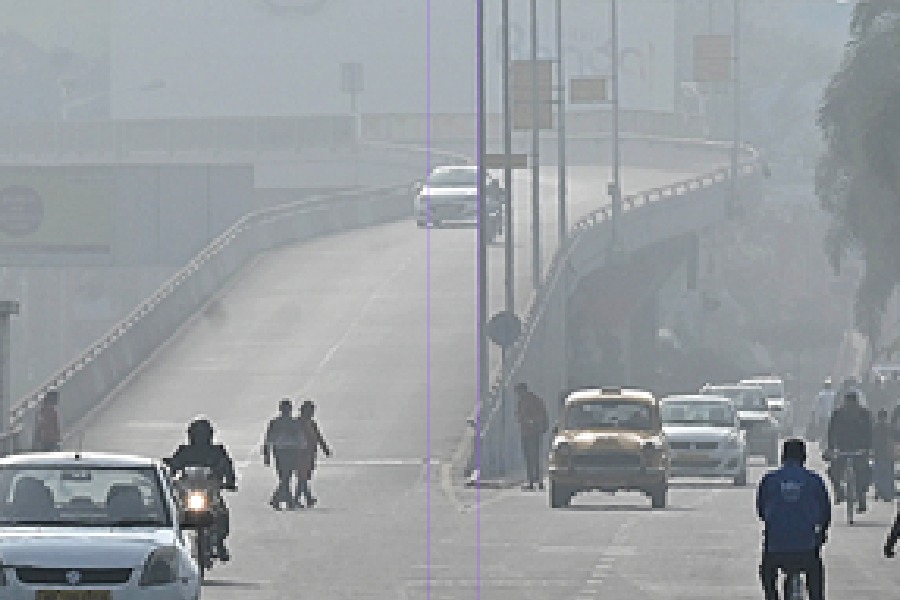The air quality in Kolkata, Howrah and Barrackpore remained “very poor” or “poor” for much of Monday, with only one of the 11 air pollution monitoring stations in the three cities recording “moderate” readings.
The steep fall in temperature — the maximum temperature on Monday was five degrees below normal — aided the rise in the air pollution levels, said scientists.
They said temperature inversion — a situation where the air layer closer to the ground is colder than the layer above it — trapped the pollutants and slowed their dispersion.
The Alipore Met office said the maximum temperature, recorded in the afternoon, was 20.2 degrees Celsius on Monday. It was five degrees below normal. The minimum temperature was 13.9 degrees, which was normal.
In Kolkata, four monitoring stations recorded “very poor” air. They are located at Ballygunge, Fort William, Jadavpur and the Victoria Memorial.
The monitoring station in Howrah’s Ghusuri, too, recorded “very poor” air.
The lone station in Barrackpore, which is located inside the state police academy, reported “poor” air.
The air was also “poor” in Howrah’s Belur Math and Puddapukur, and in Kolkata’s Rabindra Sarobar and Bidhannagar.
The only station that recorded “moderate” air is located on the Rabindra Bharati University campus on BT Road.
According to the National Air Quality Index, “very poor” can cause “respiratory illness on prolonged exposure”, “poor” air can lead to “breathing discomfort to most people on prolonged exposure” and “moderate” air can lead to “breathing discomfort to the people with lungs, asthma and heart diseases”.
All 11 stations in the three cities recorded the same air quality at 8am and also at 4pm, indicating that the air remained almost the same throughout the day.
The air quality measured at any point in time is an average of the quality over the previous 24 hours in that location.
The air quality bulletin, available on the website of the state pollution control board, showed that PM2.5, the most deadly of all air pollutants, was the prominent pollutant at most of the stations
PM2.5 are ultra-fine particles — less than 2.5 micron in size — that can enter deepest crevices of the lungs and trigger a host of critical ailments, including cancer.
“The entire greater Kolkata breathed foul air on Monday,” said a Kolkatan.
A scientist with the state pollution control board said climatological factors were responsible for the drop in air quality. The situation is unlikely to improve till the cold phase is not over.
“There is very little wind speed and owing to the cold weather, a temperature inversion has happened,” he said.
Temperature inversion meant that the air near the ground was colder than the layer above it. Usually, the air close to the ground is warmer. The warm air rises up and is replaced by cold air. This circulation helps in the dispersion of pollutants released by human activities.
“When temperature inversion happens, the air layer closer to the ground cannot rise or it rises very slowly. As a result, the pollutants remain trapped close to the ground. It happens during winter,” said a scientist.
The same volume of pollutants is released during summer and the monsoon but that does not lead to a drop in air quality because the air closer to the ground is warmer than the layer above. The warm air rises and carries away the pollutants. Besides, wind speeds are also higher during summer and the monsoon, helping in faster dispersal of pollutants.
During the monsoon, an added factor is rain, which washes away the pollutants.
But that does not mean that the authorities could not have done more to keep the air pollution under control. A resident of south Kolkata said there are still many under-construction buildings across the city that have not been covered. The dust rising from the sites spread and add to the pollution.
Besides, construction and demolition waste such as cement, sand and loose soil are dumped across Kolkata. As vehicles move past them, the dust rises, said a resident of Nagerbazar.






